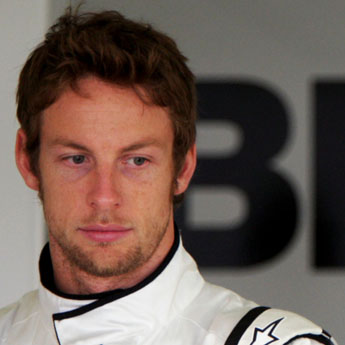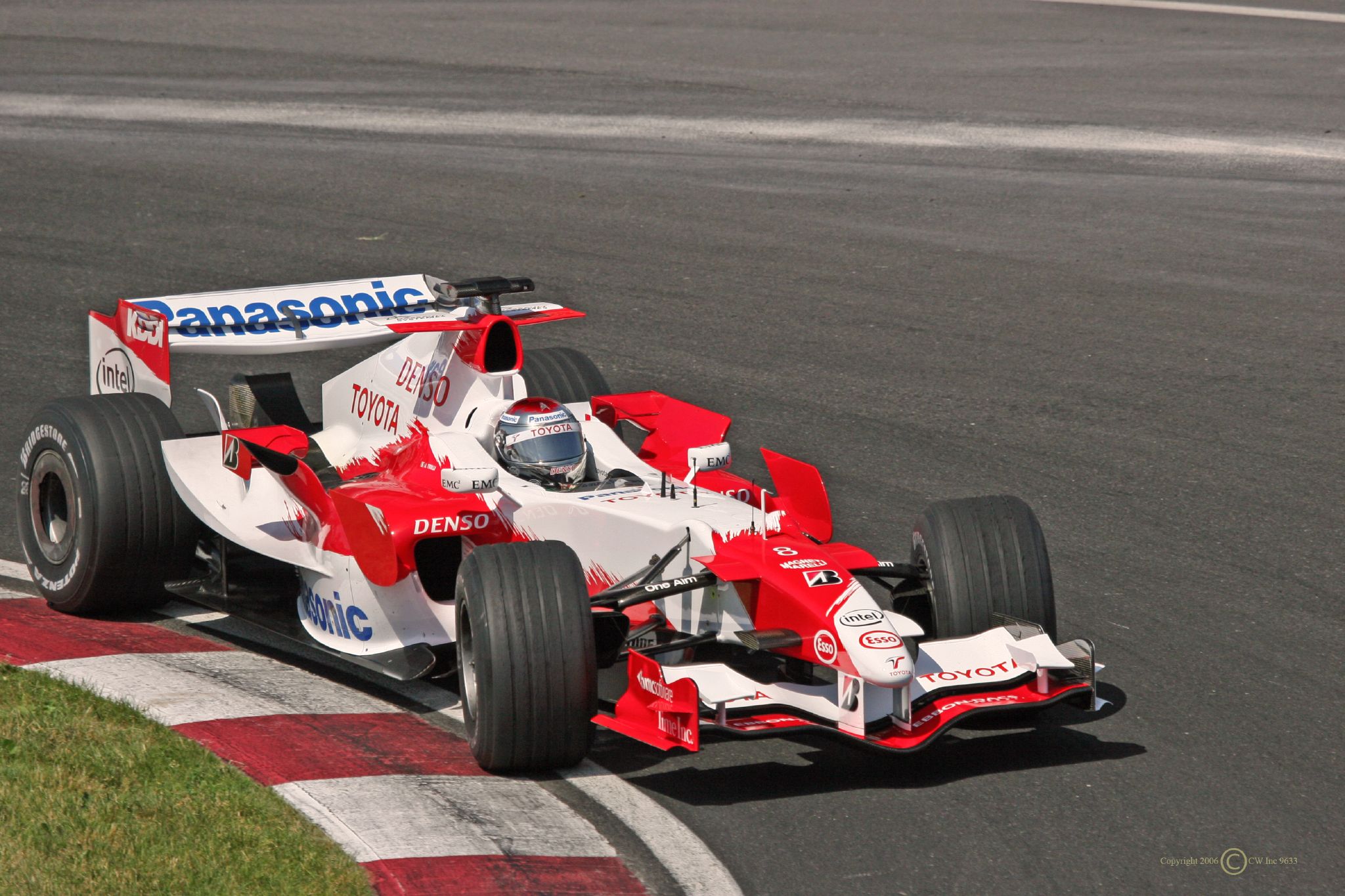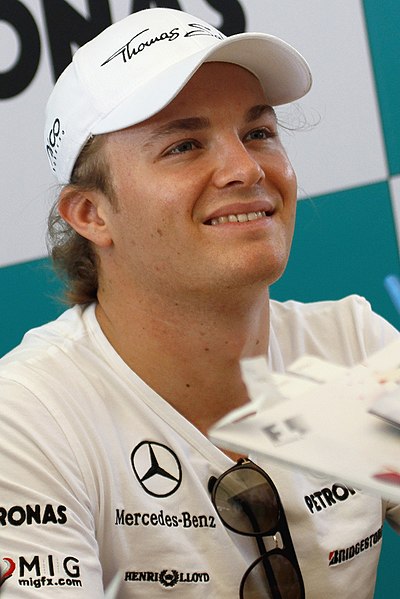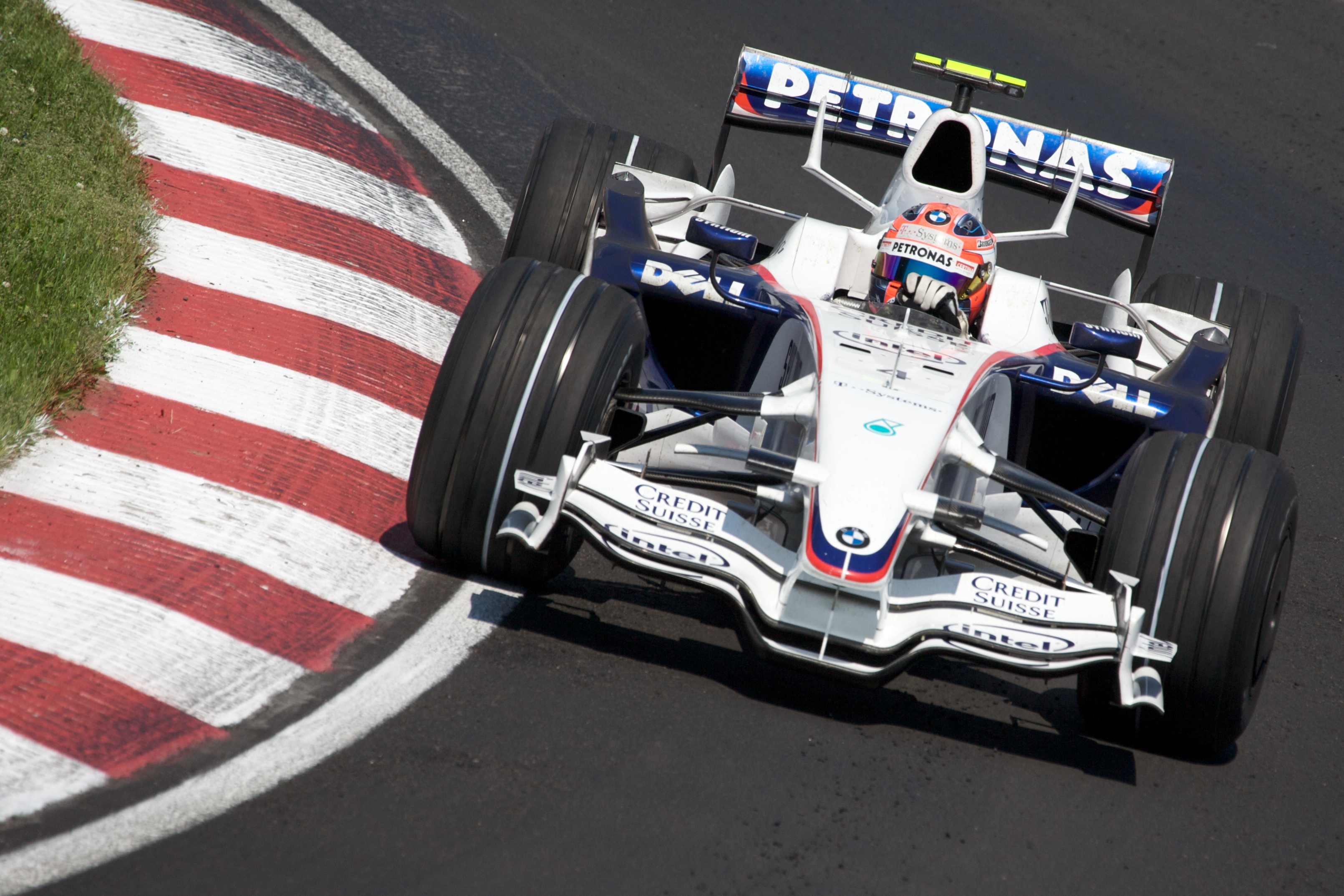 Lewis Carl Davidson Hamilton MBE (born 7 January 1985) is a British Formula One racing driver from England, currently racing for the McLaren team, and was the 2008 Formula One World Champion.
Lewis Carl Davidson Hamilton MBE (born 7 January 1985) is a British Formula One racing driver from England, currently racing for the McLaren team, and was the 2008 Formula One World Champion.Hamilton was born in Stevenage, Hertfordshire. In December 1995, at the age of ten, he approached McLaren team principal Ron Dennis at the Autosport Awards ceremony and told him, "I want to race for you one day ... I want to race for McLaren." Less than three years later McLaren and Mercedes-Benz signed him to their Young Driver Support Programme. After winning the British Formula Renault, Formula Three Euroseries, and GP2 championships on his way up the racing career ladder, he drove for McLaren in 2007, making his Formula One debut 12 years after his initial encounter with Dennis. Coming from a mixed-race background, with a black father and white mother, Hamilton is often labelled "the first black driver in Formula One". In his first season in Formula One, Hamilton set numerous records, while finishing second in the 2007 Formula One Championship, just one point behind Kimi Räikkönen. He won the World Championship the following season, ahead of Felipe Massa by the same margin of a single point. Clinching the crown thanks to passing the dry tyre-shod Timo Glock in the wet on the final lap, to take the necessary fifth position. Following that, prestigious motorsport weekly Autosport dubbed him as Last Lap Lewis. He has stated he wants to stay with the McLaren team for the rest of his F1 career. Following his 2008 title Hamilton struggled with less competitive McLarens, in spite of taking quite a few Grand Prix wins he was not able to challenge for the 2009 championship, and finished a close fourth in 2010, being in mathematical contention until the final round.
 Hamilton began karting in 1993 at the age of eight, at the Rye House Kart Circuit and quickly began winning races and Cadet class championships. At the age of ten he approached McLaren F1 team boss Ron Dennis for an autograph, and told him, "Hi. I'm Lewis Hamilton. I won the British Championship and one day I want to be racing your cars." Dennis wrote in his autograph book, "Phone me in nine years, we'll sort something out then." Hamilton drove for Martin Hines' Zip Young Guns Karting Team. From the Cadet ranks, he progressed through to Junior Yamaha (1997) and Ron Dennis actually called him in 1998 after Hamilton won an additional Super One series and his second British championship. Dennis delivered on his promise and signed Hamilton to the McLaren driver development program. This contract included an option of a future F1 seat, which would eventually make Hamilton the youngest ever driver to secure a contract which later resulted in an F1 drive. Hamilton continued his progress in the Intercontinental A (1999), Formula A (2000) and Formula Super A (2001) ranks, and became European Champion in 2000 with maximum points. In Formula A and Formula Super A, racing for TeamMBM.com, his team mate was Nico Rosberg who would later drive for the Williams and Mercedes GP teams in Formula One. Following his karting successes the British Racing Drivers' Club made him a "Rising Star" Member in 2000. In 2001, Michael Schumacher made a one-off return to karts and competed against Hamilton along with other future F1 drivers Vitantonio Liuzzi and Nico Rosberg. Hamilton ended the final in seventh, four places behind Schumacher. Although the two saw little of each other on the track Schumacher praised the young Briton (see quote box). Hamilton began his car racing career in the 2001 British Formula Renault Winter Series. Despite crashing on his third lap in the car in testing, he finished fifth overall in the winter series. This led to a full 2002 Formula Renault UK campaign with Manor Motorsport. Hamilton finished third overall with three wins and three pole positions. He remained with Manor for another year and won the championship with ten wins and 419 points to the two wins and 377 points of his nearest rival, Alex Lloyd. Having clinched the championship, Hamilton missed the last two races of the season to make his debut in the season finale of the British Formula Three Championship. Here he was less successful: in the first race he was forced out with a puncture, and in the second he crashed out and was taken to hospital after a collision with his team-mate Tor Graves. He did show his speed at both the Macau Grand Prix and Korea Super Prix, in the latter he qualified on pole position in his first visit to the track and in only his fourth F3 race. Asked in 2002 about the prospect of becoming one of the youngest ever Formula One drivers, Hamilton replied that his goal was "not to be the youngest in F1 ...but to be experienced and then show what I can do in F1". Later in 2004 Williams would announce that they had come close to signing him but were refused the opportunity due to BMW, their engine supplier at the time, refusing to fund Hamilton's career. Hamilton eventually re-signed with McLaren, and made his debut with Manor in the 2004 Formula 3 Euro Series. They won one race and Hamilton ended the year fifth in the championship. He also won the Bahrain F3 Superprix and raced one of the Macau F3 Grand Prix. Hamilton first tested for McLaren in late 2004 at Silverstone. Hamilton moved to the reigning Euro Series champions ASM for the 2005 season and dominated the championship, winning 15 of the 20 rounds. This would have been 16 but for being disqualified from one win at Spa-Francorchamps on a technical infringement that caught out several other drivers. He also won the Marlboro Masters of Formula 3 at Zandvoort. After the season British magazine Autosport featured him in their "Top 50 Drivers of 2005" issue, ranking Hamilton 24th.
Hamilton began karting in 1993 at the age of eight, at the Rye House Kart Circuit and quickly began winning races and Cadet class championships. At the age of ten he approached McLaren F1 team boss Ron Dennis for an autograph, and told him, "Hi. I'm Lewis Hamilton. I won the British Championship and one day I want to be racing your cars." Dennis wrote in his autograph book, "Phone me in nine years, we'll sort something out then." Hamilton drove for Martin Hines' Zip Young Guns Karting Team. From the Cadet ranks, he progressed through to Junior Yamaha (1997) and Ron Dennis actually called him in 1998 after Hamilton won an additional Super One series and his second British championship. Dennis delivered on his promise and signed Hamilton to the McLaren driver development program. This contract included an option of a future F1 seat, which would eventually make Hamilton the youngest ever driver to secure a contract which later resulted in an F1 drive. Hamilton continued his progress in the Intercontinental A (1999), Formula A (2000) and Formula Super A (2001) ranks, and became European Champion in 2000 with maximum points. In Formula A and Formula Super A, racing for TeamMBM.com, his team mate was Nico Rosberg who would later drive for the Williams and Mercedes GP teams in Formula One. Following his karting successes the British Racing Drivers' Club made him a "Rising Star" Member in 2000. In 2001, Michael Schumacher made a one-off return to karts and competed against Hamilton along with other future F1 drivers Vitantonio Liuzzi and Nico Rosberg. Hamilton ended the final in seventh, four places behind Schumacher. Although the two saw little of each other on the track Schumacher praised the young Briton (see quote box). Hamilton began his car racing career in the 2001 British Formula Renault Winter Series. Despite crashing on his third lap in the car in testing, he finished fifth overall in the winter series. This led to a full 2002 Formula Renault UK campaign with Manor Motorsport. Hamilton finished third overall with three wins and three pole positions. He remained with Manor for another year and won the championship with ten wins and 419 points to the two wins and 377 points of his nearest rival, Alex Lloyd. Having clinched the championship, Hamilton missed the last two races of the season to make his debut in the season finale of the British Formula Three Championship. Here he was less successful: in the first race he was forced out with a puncture, and in the second he crashed out and was taken to hospital after a collision with his team-mate Tor Graves. He did show his speed at both the Macau Grand Prix and Korea Super Prix, in the latter he qualified on pole position in his first visit to the track and in only his fourth F3 race. Asked in 2002 about the prospect of becoming one of the youngest ever Formula One drivers, Hamilton replied that his goal was "not to be the youngest in F1 ...but to be experienced and then show what I can do in F1". Later in 2004 Williams would announce that they had come close to signing him but were refused the opportunity due to BMW, their engine supplier at the time, refusing to fund Hamilton's career. Hamilton eventually re-signed with McLaren, and made his debut with Manor in the 2004 Formula 3 Euro Series. They won one race and Hamilton ended the year fifth in the championship. He also won the Bahrain F3 Superprix and raced one of the Macau F3 Grand Prix. Hamilton first tested for McLaren in late 2004 at Silverstone. Hamilton moved to the reigning Euro Series champions ASM for the 2005 season and dominated the championship, winning 15 of the 20 rounds. This would have been 16 but for being disqualified from one win at Spa-Francorchamps on a technical infringement that caught out several other drivers. He also won the Marlboro Masters of Formula 3 at Zandvoort. After the season British magazine Autosport featured him in their "Top 50 Drivers of 2005" issue, ranking Hamilton 24th. Due to his success in Formula Three, he moved to ASM's sister GP2 team ART Grand Prix for 2006. Just like their sister team in F3, ART were the leaders of the field and reigning champions having taken the 2005 GP2 crown with Nico Rosberg. Hamilton won the GP2 championship at his first attempt, beating Nelson Piquet, Jr. and Timo Glock. His performances included a dominant win at the Nürburgring, despite serving a penalty for speeding in the pit lane. At his home race at Silverstone, supporting the British Grand Prix, Hamilton overtook two rivals at Becketts, a series of high-speed (up to 150 mph in a GP2 car) bends where overtaking is rare. In Istanbul he recovered from a spin that left him in eighteenth place to take second position in the final corners. He won the title in unusual circumstances, inheriting the final point he needed after Giorgio Pantano was stripped of fastest lap in the Monza feature race. In the sprint race, though he finished second with Piquet sixth, he finished twelve points clear of his rival. His 2006 GP2 championship coincided with a vacancy at McLaren following the departure of Juan Pablo Montoya to NASCAR and Kimi Räikkönen to Ferrari. After months of speculation on whether Hamilton, Pedro de la Rosa or Gary Paffett would be paired with defending champion Fernando Alonso for 2007, Hamilton was confirmed as the team's second driver. He was told of McLaren's decision on 30 September, but the news was not made public until 24 November, for fear that it would be overshadowed by Michael Schumacher's retirement announcement. Hamilton is known for his aggressive and interesting driving style. He commonly uses oversteer to control the car's direction change. Confidence in car control allows Hamilton to excel in wet conditions as demonstrated in his performance at the 2008 British Grand Prix. Confidence is also demonstrated when overtaking, as reflected in his 32 overtakes in 4 races during 2010. His aggressive style often attracts the attention of critics. For example, critics argued that Hamilton's defensive weaving during the 2010 Malaysian Grand Prix in attempt to break the tow of Vitaly Petrov's chasing Renault was potentially dangerous. Hamilton was quick to defend himself to these accusations, but race director Charlie Whiting clarified after the race that such weaving would favour a penalty in the future. Due to the fact that Hamilton has said in the past that Ayrton Senna was his hero, some people assumed that his helmet is yellow in honour of him. In actuality it was made yellow so that his father could tell which kart his son was driving back in his karting days. Hamilton chose the colours blue, green and red and they were originally in a ribbon design; however, Hamilton later felt that the design was "a bit old hat" so it was changed. In later years a white ring was added and the ribbons moved forward to make room for adverts and logos. During the 2010 Monaco Grand Prix, Hamilton had an altered helmet design with the addition of a roulette wheel image on the top. Hamilton had said, "...I'll also be wearing a specially-painted helmet for the occasion. When you see it, you'll know why I'll be hoping for it to swing the odds in my favour."
Due to his success in Formula Three, he moved to ASM's sister GP2 team ART Grand Prix for 2006. Just like their sister team in F3, ART were the leaders of the field and reigning champions having taken the 2005 GP2 crown with Nico Rosberg. Hamilton won the GP2 championship at his first attempt, beating Nelson Piquet, Jr. and Timo Glock. His performances included a dominant win at the Nürburgring, despite serving a penalty for speeding in the pit lane. At his home race at Silverstone, supporting the British Grand Prix, Hamilton overtook two rivals at Becketts, a series of high-speed (up to 150 mph in a GP2 car) bends where overtaking is rare. In Istanbul he recovered from a spin that left him in eighteenth place to take second position in the final corners. He won the title in unusual circumstances, inheriting the final point he needed after Giorgio Pantano was stripped of fastest lap in the Monza feature race. In the sprint race, though he finished second with Piquet sixth, he finished twelve points clear of his rival. His 2006 GP2 championship coincided with a vacancy at McLaren following the departure of Juan Pablo Montoya to NASCAR and Kimi Räikkönen to Ferrari. After months of speculation on whether Hamilton, Pedro de la Rosa or Gary Paffett would be paired with defending champion Fernando Alonso for 2007, Hamilton was confirmed as the team's second driver. He was told of McLaren's decision on 30 September, but the news was not made public until 24 November, for fear that it would be overshadowed by Michael Schumacher's retirement announcement. Hamilton is known for his aggressive and interesting driving style. He commonly uses oversteer to control the car's direction change. Confidence in car control allows Hamilton to excel in wet conditions as demonstrated in his performance at the 2008 British Grand Prix. Confidence is also demonstrated when overtaking, as reflected in his 32 overtakes in 4 races during 2010. His aggressive style often attracts the attention of critics. For example, critics argued that Hamilton's defensive weaving during the 2010 Malaysian Grand Prix in attempt to break the tow of Vitaly Petrov's chasing Renault was potentially dangerous. Hamilton was quick to defend himself to these accusations, but race director Charlie Whiting clarified after the race that such weaving would favour a penalty in the future. Due to the fact that Hamilton has said in the past that Ayrton Senna was his hero, some people assumed that his helmet is yellow in honour of him. In actuality it was made yellow so that his father could tell which kart his son was driving back in his karting days. Hamilton chose the colours blue, green and red and they were originally in a ribbon design; however, Hamilton later felt that the design was "a bit old hat" so it was changed. In later years a white ring was added and the ribbons moved forward to make room for adverts and logos. During the 2010 Monaco Grand Prix, Hamilton had an altered helmet design with the addition of a roulette wheel image on the top. Hamilton had said, "...I'll also be wearing a specially-painted helmet for the occasion. When you see it, you'll know why I'll be hoping for it to swing the odds in my favour."








































